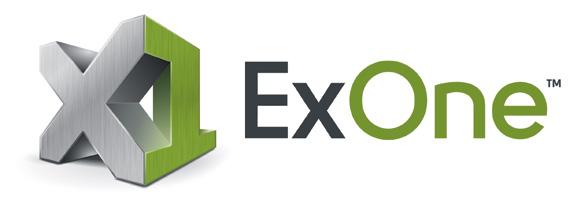
16 minute read
EXONE
Innovative, Sustainable, Cutting-Edge: Foundries Step into the Future with 3D Printing Technology
Yenilikçi, Sürdürülebilir, Son Teknoloji: Dökümhaneler, 3B Yazıcı Teknolojisi ile Geleceğe Adım Atıyor
Advertisement
Eisengiesserei Mezger, a Swiss iron foundry, expanded its services with a highly automated 3D printing system from ExOne – making the jump into new markets İsviçreli bir demir dökümhanesi olan Eisengiesserei Mezger AG, ExOne firmasının son derece gelişmiş otomatik 3B yazıcı sistemleri ile hizmetlerini genişleterek yeni pazarlara girdi
ExOne 3D printer S-Max Pro Furan with two boxes and numerous features ExOne 3D yazıcı S-Max Pro Furan, iki tablali ve çok sayıdaki özellikleri ile birlikte
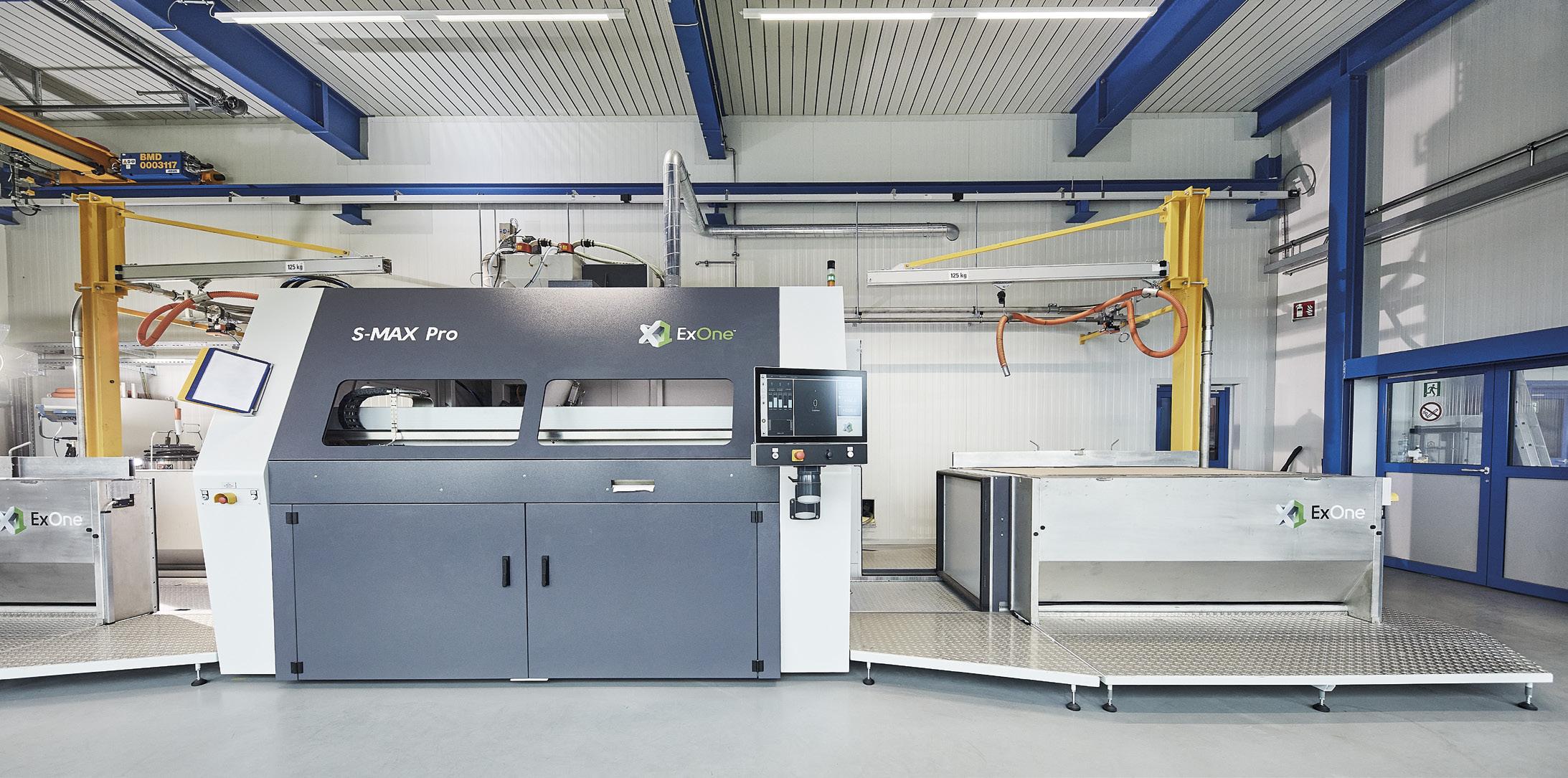
Dusty, dark and hot is how many people imagine the inside of a foundry. In the production halls at Eisengiesserei Mezger AG, however, visitors are met with an unusually clean workspace: An innovative 3D printing system from ExOne takes center stage in a new building. The Swiss company is now using cutting-edge 3D printing technology to produce its cores and molds. With its patented binder jetting technique, the 3D printer creates the sand products from a single piece and in a completely automated process. This means that the tradition-steeped iron foundry is becoming a driver of innovation, and one which knows how to benefit from the advantages offered by 3D printing; namely greater flexibility in molding, lower costs and quicker production times for parts with complex structures. Production speed the decisive factor for entering into 3D printing. Pek çok kişinin dökümhane tasviri tozlu, karanlık ve sıcak şeklindedir. Ancak, Eisengiesserei Mezger AG‘deki üretim binalarında ziyaretçiler alışılmadık derecede temiz bir çalışma ortamı ile karşılaşıyorlar: Yeni binanın merkezinde, ExOne’nın yenilikçi bir 3B yazıcı sistemi yer alıyor. İsviçreli şirket şimdi maça ve kalıplarını üretmek için en son 3B yazıcı teknolojisini kullanıyor. Patentli reçine püskürtme (binder jetting) tekniğiyle 3B yazıcı, ürünleri kumdan tek parça ve tamamen otomatik bir işlemle oluşturmaktadır. Bunun anlamı, geleneksel bir demir dökümhanesinin yaratıcılığın gücü haline gelmesi ve 3B yazıcının sunduğu avantajlardan nasıl yararlanılacağını; kısaca kalıp yapımında daha fazla esneklik, daha düşük maliyet ve karmaşık yapılara sahip parçalar için daha hızlı üretim yapabilmesidir.
Production speed the decisive factor for entering into 3D printing
Eisengiesserei Mezger AG, founded in 1946, is now part of Camponovo Holding AG. Its headquarters are in Kallnach, Switzerland, around 30 km north-west of Bern. A total of 45 employees at the foundry produce around 2,500 metric (2,268 tn sh) tons of cast parts each year for customers primarily in the mechanical engineering sector. The foundry also supplies parts to customers in the gas and water supply sector, as well as in engine and tool manufacturing. “Our foundry focuses primarily on prototypes, limited-run series and replacement parts for national and international customers,” explained Silvio Camponovo, CEO. “Speed in production is the main factor here and one of the reasons we decided to use a 3D printer.”
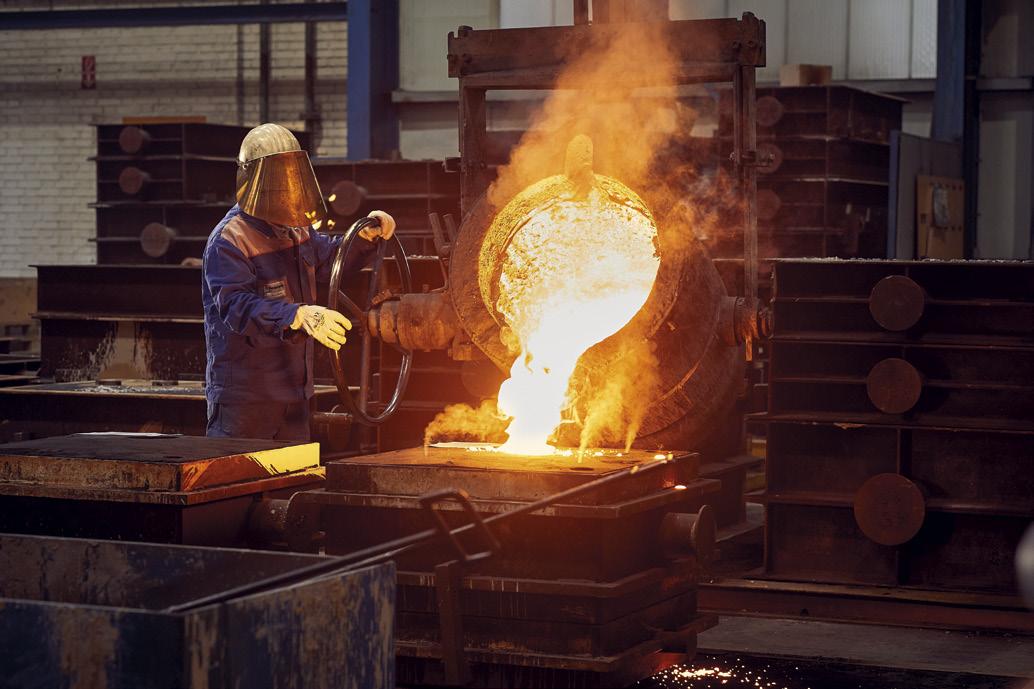
At the Gießereitag 2018 [conference for the foundry sector] in Salzburg, Mezger AG initiated contact with ExOne. “With ExOne, we had an expert partner at our side from the very first meeting – one which knows the foundry sector well and has an exact knowledge of everything that is required,” reported Dieter Diebold, Head of Sales and Foundry at Eisengiesserei Mezger AG. “From planning, all the way up to starting operations, ExOne provided us with expert support.”
3D printing system is at the cutting edge of technology
An S-Max Pro™ 3D printer from ExOne, which was put into operation in June 2020, sits at the heart of the system; the solution uses the patented ExOne binder jetting printing procedure and was equipped with numerous additional features at the request of Mezger AG. ExOne offers these features as options within its modular portfolio, and they include the Fluidmatic material supply system, the Jobmatic automatic jobbox replacement function and a desanding station.
Mezger AG prints cores and molds for iron casting in the foundry. Unlike traditionally manufactured core packages, which are often made up of multiple parts for complex molds, this process enables the number of molded parts to be reduced significantly, thereby reducing the amount of postprocessing required. The more complex the shape of the molds
Üretim hızı; 3B yazıcıyı kullanmak için belirleyici faktör
1946 yılında kurulan Eisengiesserei Mezger AG, artık Camponovo Holding AG‘nin bir parçasıdır. Merkezi, Bern‘in yaklaşık 30 km kuzeybatısında, İsviçre‘nin Kallnach şehrindedir. Dökümhanedeki toplam 45 çalışan, başta makine sektöründeki müşteriler olmak üzere her yıl yaklaşık 2.500 metrik ton döküm parça üretmektedir. Dökümhane ayrıca petrokimya sektörünün yanı sıra motor ve takım imalatı alanındaki müşterilere de parça tedarik etmektedir. CEO Silvio Camponovo “Dökümhanemiz öncelikle ulusal ve uluslararası müşteriler için prototipler, düşük adetli üretim ve yedek parçalara odaklanıyor” “Üretimdeki hız burada ana faktördür ve 3B yazıcı kullanmaya karar vermemizin nedenlerinden biridir.”
Salzburg‘daki Gießereitag 2018 [dökümhane sektörü konferansında] Mezger AG, ExOne ile temasa geçmiştir. Eisengiesserei Mezger AG Satış ve Dökümhane Müdürü Dieter Diebold “ExOne ile ilk toplantıdan beri yanımızda uzman bir ortak vardı – dökümhane sektörünü iyi bilen ve gereken her şey hakkında kesin bilgiye sahip bir ortak“ “Planlamadan, operasyonlara başlamaya kadar ExOne bize uzman desteği sağladı.”
3B yazıcı sistemi teknolojinin geldiği son noktada
Haziran 2020 ‚de hizmete giren ExOne’dan bir S-Max Pro 3B yazıcı, sistemin merkezinde yer almaktadır; çözüm, patentli ExOne reçine püskürtmeli yazıcı tekniğini kullanmaktadır ve Mezger AG‘nin talebi üzerine sayısız ek özellik ile donatılmıştır. ExOne bu özellikleri modüler portföyündeki seçenekler olarak sunmakta ve reçine transfer sistemi, Jobmatic otomatik yazıcı kutusu değiştirme işlevi ve bir kumdan arındırma istasyonunu içermektedir.
Mezger AG dökümhanede demir dökümü için maça ve kalıpları basmaktadır. Bu işlem, geleneksel olarak genellikle birden fazla parçadan oluşan karmaşık kalıplarla üretilen maça paketlerinin aksine, kalıp parça sayısının önemli ölçüde düşürülmesi ve böylece gerekli son işlem miktarının azaltılmasını sağlamaktadır. Kalıpların ve maçaların şekli ne kadar karmaşık olursa, 3B baskının faydaları da o kadar be-
Deslagging of the liquid cast iron Dökme demirin cürufunun giderilmesi

and cores, the more apparent the benefits of 3D printing become. The size of the casts varies between 0.1 kg (0.2 lbs) and 4,500 kg (9,921 lbs). “We previously procured our cores and molds from suppliers,” said Diebold. “However, as our requirements continued to grow, and, as a reliable partner to our customers, we also wanted to be able to react to requests at short notice, we decided to take production into our own hands.”
3D printing elevates Eisengiesserei Mezger to a technology partner
Thanks to 3D printing, Mezger can now support its clients along the entire value chain – from development, to engineering, all the way up to production. The expertise of the foundry is particularly useful when it comes to designing parts, as the customers are often unaware of the possibilities offered by 3D printing. The technology enables the foundry to be flexible when it comes to the design and realization of casting molds. It provides feedback on design plans and can quickly react to changes to the object through modifications to the CAD model. “The new possibilities that open up to foundries thanks to 3D printing mean that they are increasingly regarded as service providers and technology companies. Furthermore, the investments in innovative technologies are strengthening the trust of end customers in foundries,” explained Frank Betzler, Regional Sales Manager at ExOne.
From CAD model to 3D-printed mold
A CAD model is a 3D image that serves as the basis for the printed molds. It is transferred to the 3D printer on a USB, or via a network connection. The S-Max Pro at Mezger AG is equipped with two jobboxes and Jobmatic, a function that enables the jobboxes to automatically move into the 3D printer. On the base plate of
Plant operator in front of the S-Max Pro S-Max Pro‘nun Operatör Paneli lirgin hale gelmektedir. Dökümlerin boyutları 0,1 kg ile 4500 kg arasında değişmektedir. Diebold “Daha önce maçalarımızı ve kalıplarımızı tedarikçilerden tedarik ediyorduk” “Ancak, gereksinimlerimiz büyümeye devam müşterilerimizin güvenilir bir iş ortağı olarak, taleplere kısa sürede yanıt verebilmek için, üretimi kendimiz yapmaya karar verdik.”
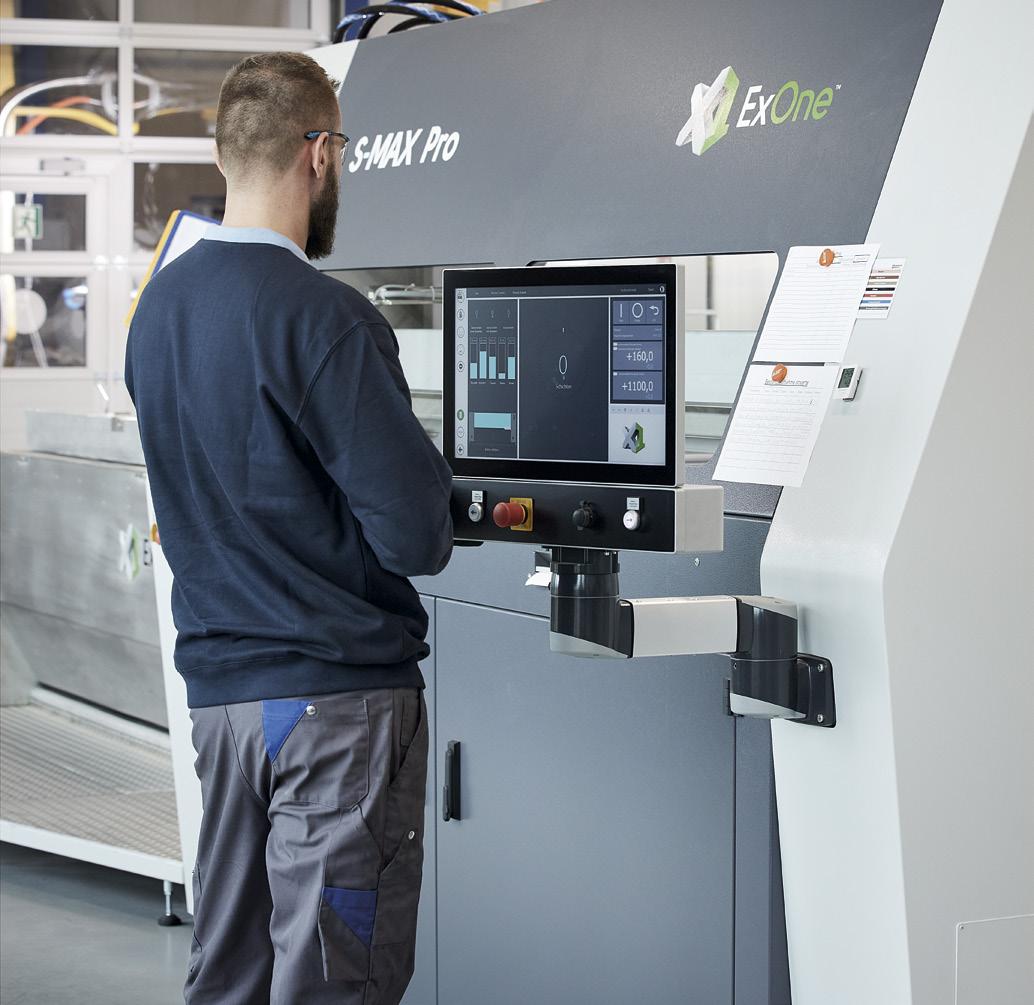
3B yazıcı Eisengiesserei Mezger’i teknoloji ortağı konumuna yükseltiyor
Mezger, 3B yazıcı teknolojisi sayesinde artık müşterilerini ürün geliştirmeden mühendislik hizmeti dahil üretime kadar olan tüm değer zinciri boyunca destekleyebiliyor. Müşterilerin genellikle 3B yazıcının sunduğu olanaklardan habersiz olması nedeniyle, dökümhane deneyimi özellikle parça tasarımı söz konusu olduğunda yararlıdır. Teknoloji, dökümhanenin döküm kalıplarının tasarımı ve yapımında esneklik sağlamaktadır. Tasarım planları hakkında geri bildirim sağlar ve ürün değişiklikleri ürün CAD modelinde yapılan değişikliklerle hızlıca yapılabilir. ExOne Bölge Satış Müdürü Frank Betzler“3B baskı teknolojisi sayesinde dökümhanelere sunulan yeni olanaklar, giderek daha fazla hizmet sağlayıcı ve teknoloji şirketi olarak kabul edildikleri anlamına geliyor. Ayrıca, yenilikçi teknolojilere yapılan yatırımlar, müşterilerin dökümhanelere olan güvenini güçlendiriyor”
CAD modelinden 3B yazıcıdan kalıba
CAD modeli, üretim için temel teşkil eden 3B bir görüntüdür. USB veya ağ bağlantısı 3B yazıcıya aktarılır. Mezger AG’deki S-Max Pro, otomatik olarak 3B yazıcıya taşınmasını sağlayan bir işlev olan iki yazıcı tablası ve Jobmatic ile donatılmıştır. Yazıcıda tabla taban plakasına önce ince ve homojen bir kum tabakası uygular. Yazıcı kafası, CAD modeline uygun olarak bağlayıcı maddeyi maçayı oluşturmak için birleştirilecek noktalara yayar. Mezger’in kullandığı reçine olan furan, her bir kum tanesini hassas bir şekilde çevreler. Taban plakası daha sonra kaplayıcının yeni bir kum tabakası uygulayabilmesi için minimum indirilir. Bu adımlar yeterli kum tabakaları yapıştırılıp, tabaka tabaka kalıp oluşturuluncaya kadar tekrarlanır.
Yazdırma işlemi tamamlandığında, yazdırılan parçaların bulunduğu kutu otomatik olarak yazıcıdan çıkar. Tek bir yazma işlemi üretilen parça sayısı, parçaların boyutuna ve şekline bağlıdır. Diebold “pompa sektöründeki müşterilerimizden biri için bir pervane ürettik” “Tek bir yazdırma prosedüründe bu ürünün en fazla 20 maçası yazdırılabilir. Bu nedenle, tüm süreç müşterinin başlangıçta beklediğinden önemli ölçüde daha hızlıydı.” Yazdırma süresi, yazdırılacak parçalara bağlıdır. En iyi , dökümhane S-Max Pro kullanarak üç iş günü içinde ham döküm parçası üretebilir. 1260 litre hacme sahip bir yazıcı kutusunun yazdırılabilir hacminin tamamı kullanılırsa, yaklaşık 1800 kg kum işlenir. Döküm, müşterinin gereksinimlerine bağlı olarak farklı kalitelerde gri dökme demir veya sünek demir kullanır.
Otomasyon, yüksek ücretli bir ülkede rekabet avantajıdır Mezger‘de kurulu sisteme özgü otomasyon seviyesi özellikle
the jobbox, the recoater in the printer first applies a thin, even layer of sand. In accordance with the CAD model, the printhead distributes the binder on the points which are to be joined together to make up the core. The binder, which at Mezger is furan, precisely surrounds each individual grain of sand. The base plate is then lowered minimally so that the recoater can apply a new layer of sand. These steps are repeated until sufficient layers of sand are adhered, and the mold is created layer by layer.
Once the printing process is complete, the jobbox automatically moves out of the printer. The number of parts manufactured during a single printing process depends on the size and shape of the parts. “For one of our customers in the pump sector, we produced an impeller / pump wheel,” said Diebold. “Up to 20 cores of this product can be printed in a single printing procedure. The entire process was therefore significantly quicker than the customer had initially expected.” The printing duration is dependent on the parts to be printed. In the best case, the foundry can produce a raw cast part within three working days using the S-Max Pro. If the entire printable volume of a jobbox – which has a volume of 1,260 liters (76,890 in³) – is used, approximately 1,800 kg (3,968 lbs) of sand (FS003) is processed. Casting uses different qualities of gray cast iron or ductile iron, depending on the customer’s requirements.
Automation is a competitive advantage in a high-wage country
The level of automation inherent to the system installed at Mezger is especially high. “It was very important to us that ExOne supplied us with an almost completely automated printing system,” explained Camponovo. “Switzerland is a country with high salaries, so it is worthwhile to invest in automation technology.” As a systems supplier, ExOne combined the selected elements in line with Mezger’s requirements, in order to achieve the highest possible level of automation in the 3D printing system. The system is equipped with a semiautomatic desanding station and the Fluidmatic system, which automatically fills the printer with binding, activating and cleaning agents. A 24-hour sand supply continuously provides molding material to the two jobboxes. The ExOne printer applies a layer of sand in 22 seconds, with the printing time alone for a completely full jobbox taking around 12 hours. This interplay between the individual automation components allows the system to operate for as long as 24 hours without the need for manual intervention. “The printer can run around the clock without any issues – in two-shift operation, with only one employee needed per shift,” said Betzler. “We realize the level of automation according to customer wishes. From a high degree of automation, all the way down to predominantly manual operation, almost anything is possible.”
And when it comes to recruiting staff, the cutting-edge equipment, which makes the company a pioneer in innovative manufacturing methods, represents a further advantage: On the one hand, the large investments show that Mezger AG has long-term plans to remain at its Kallnach site. On the other hand, the extensive system shows that the company
3D printer supplies, including FluidMatic, Sand supply 24/7 3D Yazıcı besleme ünitesi, reçine, ve 24/7Kum depolama bunkerleri yüksektir. Camponovo “ExOne‘ın bize neredeyse tamamen otomatik bir sistemi sağlaması bizim için çok önemliydi” “İsviçre, ücretlerin yüksek olduğu bir ülke, bu yüzden otomasyon teknolojisine yatırım yapmaya değer.” Bir sistem tedarikçisi olarak ExOne, 3B yazıcı sisteminde mümkün olan en yüksek otomasyon seviyesini elde etmek için seçilen elemanları Mezger‘in gereksinimleri doğrultusunda birleştirdi. Sistem, yazıcıyı otomatik olarak reçine, aktivatör ve temizleme maddeleriyle dolduran yarı otomatik bir kum istasyonu ve akışkan sistemi ile donatılmıştır. 24 saatlik bir kum kaynağı, sürekli olarak iki sisteme sarf malzemesi sağlar. ExOne yazıcı 22 saniyede bir kum katmanı uygular ve tamamen dolu bir yazıcı kutusu için yazdırma süresi yaklaşık 12 saat sürer. Bireysel otomasyon bileşenleri arasındaki bu etkileşim, sistemin manuel müdahaleye gerek kalmadan 24 saat boyunca çalışmasını sağlar. Betzler „Yazıcı her vardiyada yalnızca bir çalışana ihtiyaç duyulan iki vardiyalı bir operasyonda herhangi bir sorun yaşamadan 24 saat çalışabiliyor”. “Otomasyon seviyesini müşteri isteklerine göre gerçekleştiriyoruz. Yüksek derecede otomasyondan, ağırlıklı olarak manuel çalışmaya kadar hemen hemen her şey mümkün.”

Personel alımı söz konusu olduğunda ise, şirketi yenilikçi üretim yöntemlerinde bir öncü haline getiren son teknoloji ekipman daha fazla avantaj sağlar: Bir yandan büyük yatırımlar Mezger AG‘nin Kallnach tesisinde uzun vadeli planları olduğunu göstermektedir. Öte yandan, kapsamlı sistem, şirketin 3 teknolojisinin sahip olduğu potansiyeli tanımladığını ve bu teknolojik ilerlemeyi şirketin geleceğini güvence altına almak için nasıl kullanacağını bildiğini göstermektedir. Bu girişimcilik vizyonu, keyifli bir çalışma ortamı ile birleştiğinde, uzman işçilere, genç yeteneklere ve çıraklara hitap eder, böylece uzmanların eksikliğini telafi eder.
Kaynakların çevre dostu kullanımı
Mezger, Diebold‘un açıkladığı gibi, daha özel bir konuya değer vermektedir: “Otomasyonun yanı sıra, üretim malzemelerinin mümkün olduğunca sürdürülebilir bir şekilde kullanılması bizim için büyük öneme sahipti. Kum bunda büyük bir rol oynuyor” Atık ve bertaraf maliyetlerini en aza indirmek için, yeni kum geri dönüştürülmüş kum ile
has identified the potential held by 3D technology and knows how to use this technological progress to secure the future of the company. This entrepreneurial vision, combined with a pleasant working environment, appeals to specialist workers, young talents and apprentices, thereby compensating for the lack of specialized experts in the field.
Environmentally friendly use of resources
Mezger values a further special factor, as Diebold explains: “Alongside automation, it was of great importance to us that the production materials are used as sustainably as possible. The sand plays a large part in this,” Diebold says. To minimize waste and disposal costs, the fresh sand is mixed with a certain proportion of recycled sand. Recycled sand is generated as a by-product during the printing process: Every layer of sand has to cover the complete base plate area in the jobbox, all the way up to the side walls, as the sand assumes a supporting function during the printing process. Just how much sand is glued with the binder depends on the shape of the parts to be printed. Once the printing process is complete, the base plate is lifted at the push of a button, enabling the unglued sand to flow into the funnels at the longitudinal sides of the jobbox. The sand is then fed into a recycling container, where it is extracted for the next job and mixed with fresh sand. “The content of recycled sand in a printing process is generally between 30 and 50 percent,” explained Betzler. “Mezger AG determined the optimum mixing ratio for its products through several tests, and was able to increase the content of recycled sand to up to 80 percent, while retaining the same process reliability.”
3D printing will tap into more markets in the future
In the first four months in which Mezger’s system has been in operation, the initial response has been overwhelmingly positive: “Thanks to ExOne’s support, the commissioning of the printer went absolutely smoothly,” said Camponovo. “In the meantime, we have been able to observe various benefits in our production: We have been able to produce more quickly, and the printed cores have impressed us with their high quality, as well as the flexibility in design options.”
The expansion of the service portfolio, the development of new business areas and the growing diversity of products are all indicators that the investment costs will be amortized over the next few years. At the moment, Mezger is using the S-Max Pro primarily for small series production, for replacement parts and for prototypes; however, the Swiss company expects the numbers of parts produced to grow in the future. 3D printers are particularly well suited for complex shapes with undercuts, especially when they are as highly automated as the system at Mezger. “We expect 3D printing in foundries to play an even larger role in the future,” said Camponovo. “We are already thinking about investing in another 3D printing system if orders continue to rise.” karıştırılır. Geri dönüştürülmüş kum, yazıcı işlemi sırasında bir yan ürün olarak üretilir: Her kum katmanı, yazma işlemi sırasında bir destek işlevi üstlendiğinden, yan duvarlara kadar, baskı kutusu içindeki tüm baskı plaka alanını kaplamak zorundadır. Reçine, ne kadar kum yapıştırıldığı, yazılacak parçaların şekline bağlıdır. Baskı işlemi tamamlandıktan sonra, taban plakası bir düğmeye basılarak kaldırılır ve yapıştırılmamış kumun yazıcı kutusunun uzun taraflarındaki hunilere akması sağlanır. Kum daha sonra bir sonraki iş için çıkarıldığı ve yeni kumla karıştırıldığı bir geri dönüşüm kabına beslenir. Betzler “Bir yazıcı işleminde geri dönüştürülmüş kumun içeriği genellikle yüzde 30 ila 50 arasındadır” “Mezger AG, çeşitli testlerle ürünleri için optimum karıştırma oranını belirledi ve aynı işlem güvenilirliğini korurken geri dönüştürülmüş kum içeriğini yüzde 80 ‚e kadar artırabildi.”
3B yazıcı gelecekte daha fazla pazara girecek
Mezger‘in sisteminin çalışmaya başladığı ilk dört ayda, ilk yorumlar son derece olumlu olmuştur: Camponovo “ExOne‘ın desteği sayesinde, yazıcının devreye alınması kesinlikle sorunsuz geçti” “Bu arada üretimimizde çeşitli faydaları gözlemleyebildik: Daha hızlı üretim yapabildik, maça tasarım seçeneklerindeki esnekliğin yanı sıra yüksek kalitesiyle de bizleri etkiledi.”
Hizmet portföyünün genişlemesi, yeni iş alanlarının geliştirilmesi ve ürün çeşitliliğinin artması, yatırım maliyetlerinin önümüzdeki birkaç yıl içinde göstergesidir. Şu anda Mezger, S-Max Pro‘yu öncelikle küçük seri üretimler, yedek parçalar ve prototipler için kullanmaktadır; ancak İsviçreli şirket, üretilen parça sayısının artmasını beklemektedir. 3B yazıcılar, özellikle Mezger‘deki sistem kadar yüksek oranda otomatikleştirildiklerinde, alttan kesimli karmaşık şekiller için çok uygundur. Camponovo “Dökümhanelerde 3 baskının gelecekte daha da büyük bir rol oynamasını bekliyoruz” “Siparişler artmaya devam ederse başka bir 3B yazıcı sistemine yatırım yapmayı düşünüyoruz.”
CAD drawing of the 3D printing object
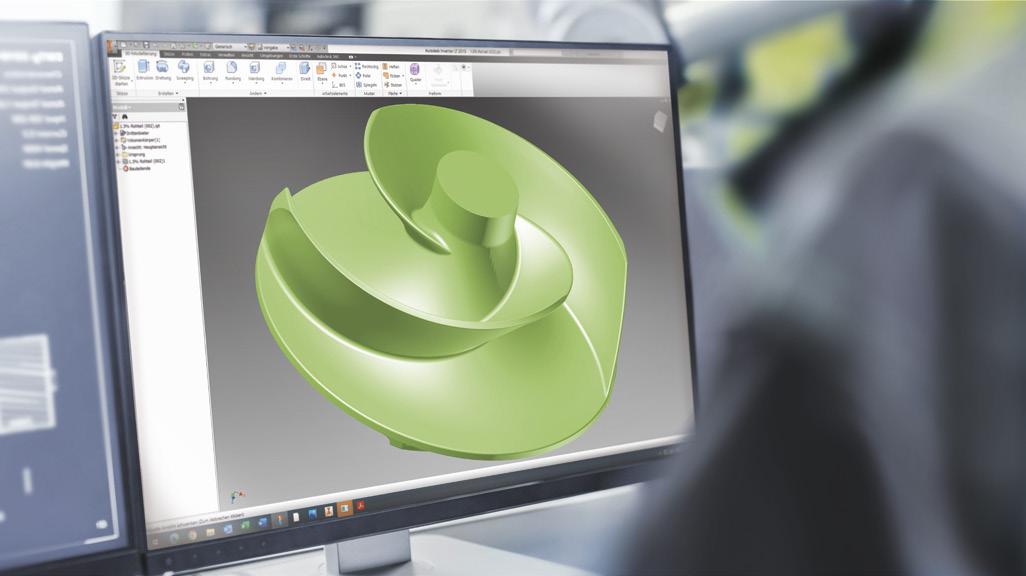
EUROPEAN HEADQUARTERS
ExOne GmbH Gersthofen, Germany europe@exone.com +49 821 65063-0 www.exone.com









